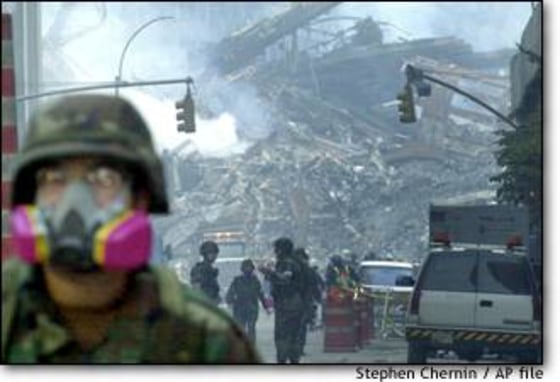The burning ruins of the World Trade Center spewed toxic gases “like a chemical factory” for at least six weeks after the Sept. 11, 2001, attacks despite government assurances the air was safe, according to a study released on Wednesday. The study follows the release of a government report that the White House directed the Environmental Protection Agency to give New Yorkers misleading assurances about the health risk.
The study found that the gases of toxic metals, acids and organics were capable of penetrating deeply into the lungs of workers at Ground Zero.
Lead study author Thomas Cahill, a professor of physics and engineering at the University of California at Davis, said conditions would have been “brutal” for workers without respirators and slightly less so for those working or living in adjacent buildings.
“The debris pile acted like a chemical factory,” Cahill said in a statement issued along with the study, which was released at a meeting of the American Chemical Society in New York. “It cooked together the components and the buildings and their contents, including enormous numbers of computers, and gave off gases of toxic metals, acids and organics for at least six weeks.”
Four types of particles
The researchers noted that tons of concrete, glass, furniture, carpets, insulation, computers and papers burned until Dec. 19, 2001.
Some elements of the debris combined with organic matter and chlorine from papers and plastics and escaped to the surface as metal-rich gases that either burned or chemically decomposed into very fine particles that could easily penetrate deep into human lungs, the study found.
Specifically, the study said samples from Ground Zero found four types of particles listed by the EPA as likely to harm human health:
Fine metals that can damage lungs.
Sulfuric acid that attacks lung cells.
Fine undissolvable particles of glass that can travel through the lungs to the bloodstream and heart.
High-temperature carcinogenic organic matter.
“For each of these four classes of pollutant,” Cahill said, “we recorded the highest levels we have ever seen in over 7,000 measurements we have made of very fine air pollution throughout the world.”
The study did find that by May 2002, the levels of nearly all the fine components had declined more than 90 percent.
Fallout over assurances
The report comes amid questions about what the public was told by the Bush administration.
Last month, an internal report by EPA Inspector General Nikki Tinsley said the White House pressured the agency to make premature statements that the air was safe to breathe.
The EPA issued an air quality statement on Sept. 18, 2001, even though it “did not have sufficient data and analyses to make the statement,” the report said.
The White House “convinced EPA to add reassuring statements and delete cautionary ones” by having the National Security Council control EPA communications in the days after Sept. 11, the report said. Among the information withheld was the potential health hazards of breathing asbestos, lead, concrete and pulverized glass, the report said.
New York leaders including Sen. Hillary Clinton have called on the Justice Department to investigate.
‘Best professional judgement’
EPA acting administrator Marianne Horinko has defended the agency, saying it used the best information it had available.
“It was using our best professional judgment; it was not as a result of pressure from the White House,” she said. “The White House’s role was basically to say, ‘Look, we’ve got data coming in from everywhere. What benchmarks are we going to use, how are we going to communicate this data? We can’t have this Tower of Babel on the data.’”
It wasn’t until June 2002 that the EPA determined that air quality had returned to pre-Sept. 11 levels — well after respiratory ailments and other problems began to surface in hundreds of workers cleaning dusty offices and apartments.
The inspector general found that EPA was convinced to omit guidance for cleaning indoor spaces and tips on potential health effects from airborne dust containing asbestos, lead, glass fibers and concrete.
The Associated Press and Reuters contributed to this report.
